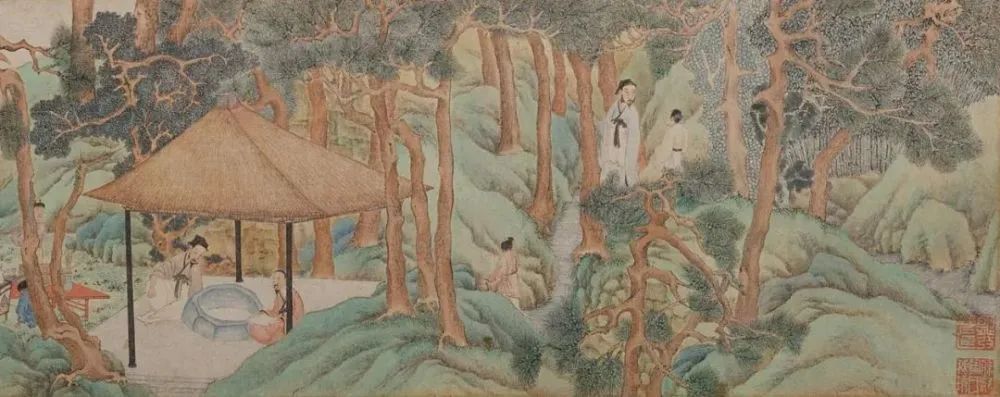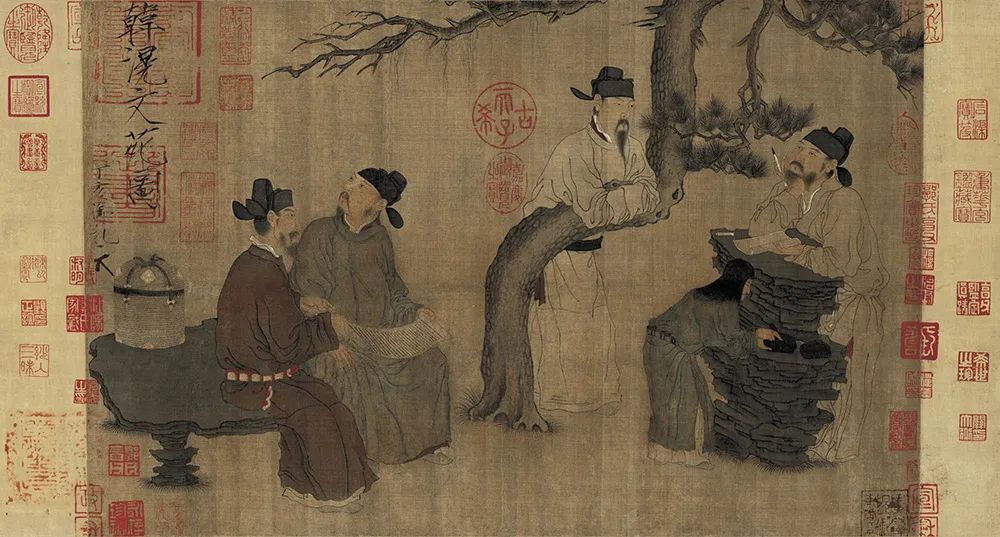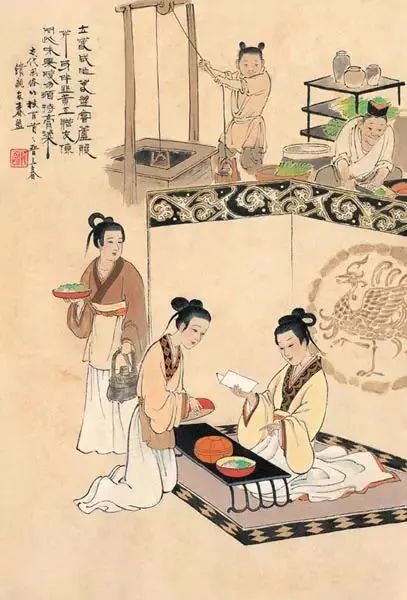
Huishan Tea Party by Wen Zhengming, Ming Dynasty, housed in the Palace Museum 明文徵明《惠山茶会图卷》,故宫博物院藏
Apart from xiangchun, celery and Chinese chives, what else could ancient Chinese eat during springtime? Now let's check out more.
除了上期提到的香椿、芹菜和韭菜,古人们在春天还喜欢吃什么呢?今天,我们就来看看其他春季流行食材。

Yuan Mei, a renowned scholar-bureaucrat in the Qing Dynasty, had great interest in cooking materials as well.
来自钱塘(今浙江杭州)的清代士大夫袁枚对春天的食材研究也有所涉猎。
From his point of view, vegetables in springtime were mostly exuberantly green, such as stem mustard, the material for pickles, according to Recipes from the Garden of Contentment: Yuan Mei's Manual of Gastronomy (Suiyuan Shidan 《随园食单》). He also noted that the rich tended to prefer vegetables more than meat, which coincides with people's healthy eating philosophy nowadays.

在他的《随园食单》中,与春季有关的菜肴,是青青翠翠的,比如南京三月的“杨花菜”以及可用于腌制榨菜的台菜(芜菁)心。
他还写道:“富贵之人嗜素甚于嗜荤。”说明那时的富裕阶层已经知道茹素的种种好处,很符合现代的健康理念。
Likewise, residents of Jingchu area (the political, economic and cultural center of ancient Chu state, located in today's Hubei province), also enjoyed some sort of thick soup made with seven kinds of vegetables in spring.
无独有偶,荆楚人士在春天的饮食习惯也是“绿色”的,他们每天采摘七种菜,做成羹汤来吃。
Abundance of food materials in spring in ancient China can also be spotted from some kinds of "plates" of vegetables popular among people in different dynasties. In the Jin Dynasty, the "spring plate" holding turnips and celery, was presented as gifts.
起源于晋代的“春盘”则体现了春日食材的丰富。晋代,人们“以萝菔(即萝卜)、芹芽为菜盘相馈”。

Literati Writing Poems Under A Pine Tree, by Zhou Wenju, Five Dynasties, housed in the Palace Museum 五代周文矩《文苑图》故宫博物院藏
In the Tang Dynasty, such "plate" was served with lettuce and spring pancake, or "Chunbing", a delicacy made of bean sprouts, spinach, hotbed chives, etc.
唐代,人们将生菜和春饼(常常用豆芽、菠菜、韭黄等炒成)合为“春盘”。
People in the Northern Song Dynasty, according to one of the poems written by Su Shi, a genius who excelled at poetry, cooking and travel in that era, had made the "plate" richer in content by adding vegetable categories like tarragon and Chinese chive leaves in it.
北宋的春盘,增加了蒿菜、韭菜等蔬菜种类,所以苏轼在诗里写道:“青蒿黄韭试春盘”。

A painting portraying a Chinese dowager tasting the dish comprising five spicy vegetables, from a collection of paintings depicting Chinese ancient customs painted by Wang Hongli (1927-2019), a famous painter of serial pictures 王弘力(1927-2019)《中国古代风俗百图》一书中描绘的“馈春盘”——即品尝五辛盘。
Similar to the "sping plate" was "Wu Xin Pan (plate with five spicy vegetables)", which replaced all but Chinese chive leaves in the "spring plate" with spicy vegetables—garlic, wild garlic, brassica and coriander. The combination was believed to promote the flow of qi and blood circulation.
与春盘类似的还有“五辛盘”,五辛即五种有辛辣味的蔬菜,一般是大蒜、小蒜、韭菜、芸苔、胡荽。传统养生学理论认为,五辛可以“发五脏气”,也就是疏通气血,有利于提高机体免疫力。诗云:“立春咸作春盘尝,芦菔芹芽伴韭黄。互赠友僚同此味,果腹勿须待膏粱。”
The pungent portfolio was recommended to go with wine brewed out of Chinese citrus fruit, as what Meng Zhonghou, one of the dukes in the Northern Song Dynasty did.
五辛盘最好还要搭配黄柑酿的酒——北宋安定郡王孟忠厚用洞庭精品黄柑酿制成宫廷御酒,名曰“洞庭春色”。

Author: Yuan
Supervisor: Lv Yun
Editor: Lv Yun
Source: GZ-Maritimesilkroad (丝路云帆Silu Yunfan), official Wechat account of City Alliance for the Preservation and world Heritage Inscription of Maritime Silk Road Heritage